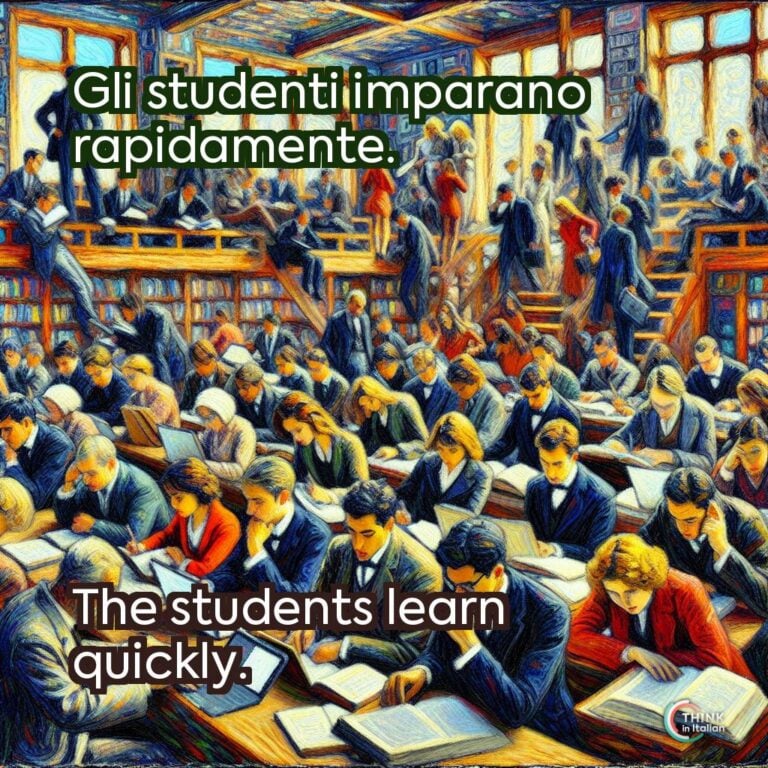What is an Adverb?
Adverbs are a key component of the language. They work as modifiers that enrich communication by providing additional details about actions, circumstances, and attributes. They can, in fact, modify verbs, adjectives, or other adverbs.
I like to think of adverbs as the ‘salt’ of the language because they are essential for bringing out the full flavor of our expressions.
Adverbs allow language users to clarify and emphasize the meaning of sentences, making their study both necessary and fascinating.
In this article, I will guide you through an exploration of Italian adverbs, which involves understanding their various types, such as those of manner, place, and time.
Italian Adverbs: Everything You Need to Know
I believe that understanding the various types of adverbs is crucial for anyone looking to master Italian.
Each type of adverb adds a unique layer of meaning, specifying different elements of the actions that are described, and, therefore, enriching the language significantly.
Most Italian adverbs are formed from adjectives. Adjectives often become adverbs by adding ‘-mente‘ to the adjectival feminine form.
This morphological change adds depth to the language, allowing users to express nuances in actions and qualities effortlessly.
In general, Italian adverbs can be divided into two main categories based on either their meaning or their morphology:
Meaning
- Adverbs of manner (lentamente – slowly)
- Adverbs of place (qui – here)
- Adverbs of time (dopo – later)
- Adverbs of frequency (spesso – often)
- Adverbs of degree (molto – very)
Morphology
- Derived adverbs with the -mente suffix (precisamente – precisely)
- Primitive adverbs which are not derived from other words (presto – early)
For instance, the adverb “lentamente” is an adverb of manner meaning-wise, but it is also a derived adverb morphology-wise.
A way I like to categorize adverbs based on their meaning is to ask myself questions. For example: Martina corre velocemente. (“Martina runs fast“).
How does Martina run? She runs fast, therefore “velocemente” is an adverb of manner, because it answers the question How?
These are the questions I ask myself to easily categorize adverbs:
| How? | Manner |
| Where? | Place |
| When? | Time |
| How often? | Frequency |
| How much? | Degree |
The Invariable Nature of Italian Adverbs
Unlike adjectives, which must grammatically agree with the nouns they describe, Italian adverbs are invariable, meaning that they do not change form based on gender or number.
This simplicity makes them easier to use than other grammatical forms and ensures they are easily recognizable within sentences.
So, dear Italian learner, I have good news for you! You do not need to memorize multiple variations of each adverb!
The invariable nature of Italian adverbs reduces the cognitive load associated with remembering agreeable forms, allowing one to focus more on vocabulary acquisition and sentence structure.
Additionally, the recognizable pattern of adverb usage in Italian can accelerate the learning process and increase confidence in both spoken and written communication.
Placement Flexibility and Its Impact
The Italian language allows a significant degree of flexibility in the placement of adverbs in sentences.
Not only can the placement of an adverb significantly influence the flow and rhythm of speech, but it can also play a critical role in how information is emphasized and understood.
This flexibility is key to mastering the effective delivery of messages in both spoken and written Italian.
The position of an adverb in a sentence can highlight certain elements over others. For instance, placing an adverb at the beginning of a sentence can set the tone for the entire statement.
For instance, consider the difference between these two sentences:
Normalmente, arrivo alle otto.
Normally, I arrive at eight.
Arrivo alle otto, normalmente.
I arrive at eight, normally.
In the first sentence, the adverb “normalmente” places emphasis on the routine nature of the action, while in the second, the emphasis shifts to the time since the adverb adds a casual note to the end of the statement.
It might not sound straightforward for a second language learner, but as a native speaker of Italian, I swear I can perceive a huge difference!
Another example that I find very fascinating occurs with the adverb solo (only). Its placement can alter the perceived meaning of the entire sentence.
For example:
Ho solo mangiato la pizza.
I only ate the pizza.
- It suggests that eating was the only action performed.
Ho mangiato solo la pizza.
I ate only the pizza.
- It implies that pizza was the only food consumed.
In these two cases, the adverb “solo” modifies different parts of the sentence, leading to different interpretations of the speaker’s actions.
If you, like me, are passionate about the interface between language and psychology, then you will love this: strategic placement of adverbs can lead to specific rhetorical or stylistic effects.
For example, placing an adverb at the end of a sentence can create a dramatic pause that underscores the adverb’s modifying effect, adding a punch to the statement’s conclusion.
This technique is often used in persuasive writing and speeches to reinforce the speaker’s point or to evoke a particular emotional response from the audience.
The ability to manipulate adverb placement not only enhances one’s capacity to convey precise meanings but also to vary sentence structure creatively and effectively.
For me, mastering the placement of adverbs is essential for anyone looking to achieve fluency in Italian.
Evolution of Italian Adverbs
The history of Italian adverbs can be traced back to the Latin language, from which Italian is directly descended.
For instance, Latin adverbs ending in -e (like forte) have often transformed into Italian adverbs ending in -mente (like fortemente, meaning strongly).
Of course, the suffix -mente is derived from Latin, specifically from the ablative feminine singular of “mens,” “mentis,” meaning mind.
During the Middle Ages, as Italian began to solidify into a more coherent language, the use of the suffix -mente became a common way to form adverbs from adjectives.
I am sure you are seeing some familiarity here! In fact, this same process occurred in English, which now transforms adjectives into adverbs by adding the suffix -ly.
The Renaissance period also influenced the Italian language: scholars and writers such as Dante, Petrarch, and Boccaccio contributed to the codification of many grammatical structures, including adverbs, using classical Latin as a model.
If you are interested in the historical roots of the Italian language, then I recommend you investigate further!
My two favorite sources to achieve a deeper historical and grammatical perspective are “The History of the Italian Language” by Giulio Lepschy and “A Reference Grammar of Modern Italian” by Maiden and Robustelli.
Let me know if you read or are planning to read these books! I am sure you will love them.
Common Italian Adverbs You Should Know
Now that you know the main grammatical characteristics of Italian adverbs, it’s time to immerse yourself in the most common and useful adverbs used by Italians.
| Italian Adverb | Translation into English | Example Sentence (Italian) | Example Sentence (English) |
| Sempre | always | Vado sempre al lavoro in bicicletta. | I always go to work by bicycle. |
| Mai | never | Non ho mai visto la neve. | I have never seen snow. |
| Già | already | Hai già finito i compiti? | Have you already finished your homework? |
| Ancora | still / yet | Non ha ancora chiamato. | He hasn’t called yet. |
| Poi | then | Mangiamo, e poi andiamo al cinema. | We eat, and then we go to the cinema. |
| Quasi | almost | È quasi mezzanotte. | It’s almost midnight. |
| Spesso | often | Vado spesso al mare d’estate. | I often go to the sea in the summer. |
| Bene | well | Questo piatto è cucinato molto bene. | This dish is cooked very well. |
| Male | badly | Parla italiano molto male. | He speaks Italian very badly. |
| Velocemente | quickly | Lui corre molto velocemente. | He runs very quickly. |
| Lentamente | slowly | La giornata passa lentamente. | The day passes slowly. |
| Facilmente | easily | Ha superato l’esame facilmente. | He passed the exam easily. |
| Raramente | rarely | Raramente mangio fuori durante la settimana. | I rarely eat out during the week. |
| Insieme | together | Andiamo insieme al cinema stasera? | Shall we go to the cinema together tonight? |
| Appena | just | Sono appena arrivato a casa. | I just got home. |
| Soprattutto | especially | Mi piace soprattutto il gelato al cioccolato. | I especially like chocolate ice cream. |
| Davvero | really | Questo libro è davvero interessante. | This book is really interesting. |
| Ovviamente | obviously | Ovviamente, non posso mancare alla tua festa. | Obviously, I can’t miss your party. |
| Purtroppo | unfortunately | Purtroppo, non posso venire con te. | Unfortunately, I can’t come with you. |
| Forse | maybe | Forse andrò in vacanza in agosto. | Maybe I will go on vacation in August. |
How Can I Use Italian Adverbs?
Beyond basic definitions, it’s very important to explore the practical applications of Italian adverbs in complex sentences.
As an Italian tutor, I noticed that many learners struggle with the appropriate use of adverbs, often misplacing them or using them inappropriately in terms of emphasis and agreement.
As I mentioned before, the placement of adverbs in Italian sentences is quite flexible, but there are general guidelines that can help you use them more effectively.
Understanding these placement rules is essential for both the correctness of the language and the nuances of meaning that different placements can convey. Here’s a detailed overview:
Position Relative to Verbs:
- Adverbs usually follow the verb they modify. For instance, in Lui mangia velocemente (He eats quickly), “velocemente” follows the verb “mangia”.
- Some adverbs of time come between the auxiliary verb and the past participle in compound tenses. For example, in ho sempre giocato a scacchi (I have always played chess).
Position with Adjectives and Other Adverbs:
- When modifying an adjective or another adverb, the adverb typically precedes the word it modifies. For example, molto interessante (very interesting) and “troppo lentamente” (too slowly).
Initial Position:
- Adverbs of manner, time, and frequency are placed at the beginning of sentences to emphasize the meaning of the whole statement, as in Di solito, lavoro da casa (usually, I work from home).
Position for Emphasis:
- Placing an adverb at the beginning of a sentence often gives it greater emphasis than if it were nestled in the middle or at the end.
Fixed Phrases:
- Some adverbs are part of fixed phrases or expressions and always appear in a specific order. For example, almeno (at least) tends to precede the phrase it modifies: Almeno una volta al giorno (At least once a day).
Emphasis and Modulation:
- Adverbs like davvero (really) and appena (just) are often used for emphasis. Their placement can affect the emotional and informative impact of a sentence.
For example
Ho davvero apprezzato.
I really appreciated).
Ho apprezzato davvero.
I did appreciate it, really.
- These sentences can convey subtly different sentiments.
Common Errors with Italian Adverbs
Among the most common errors Italian learners make when using adverbs, I selected the three most usual ones:
- Misplacement:
- The incorrect placement of adverbs within a sentence can lead to confusion about what element of the sentence the adverb is modifying.
For example, placing an adverb of manner too far from the verb it modifies can make the sentence awkward or unclear.
- Overuse of Certain Adverbs:
- Beginners might over-rely on certain adverbs like molto (very) without exploring other means to express intensity or degree, such as estremamente (extremely) or assai (quite), which could enrich their language use.
- Inappropriate Use of -mente Adverbs:
- While the -mente suffix is a productive means to form adverbs from adjectives, its misuse, especially in formal or written contexts, can sound overly formal.
Balancing these adverbs with other forms or phrases is a skill that improves with practice and exposure to native Italian usage.
You Understood Everything “Perfettamente” (Perfectly)
Have you happily read this article? Did I extensively explain Italian adverbs? Are you surely going to enroll in an Italian course? Have you intelligently understood I am using adverbs to convince you they are extremely useful?
They really are! They are fascinating not only for their grammatical function but also for their role in shaping the rhythm and mood of the language.
By mastering adverbs, you will enhance their comprehension and expression, achieving greater fluency and precision in Italian.
Practice the use of Italian adverbs with your Italian friends, alone, or with an AI tutor!




